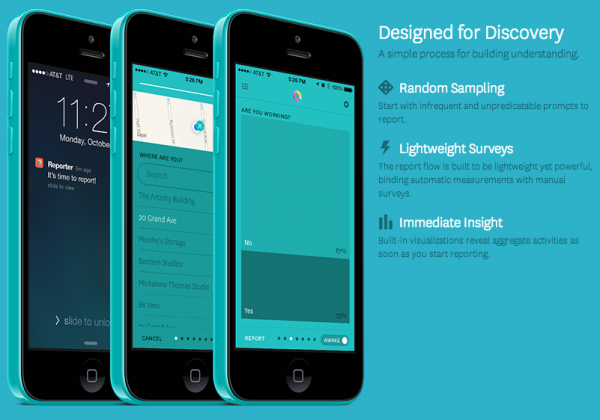Anything that aims to do that, is interesting. The reporter app from Nicholas Fetron and Drew Breunig.

“Reporter can illuminate aspects of your life that might be otherwise unmeasurable.”
– Reporter-app
Anything that aims to do that, is interesting. The reporter app from Nicholas Fetron and Drew Breunig.

“Reporter can illuminate aspects of your life that might be otherwise unmeasurable.”
– Reporter-app
“When you use Buycott to scan a product, it will look up the product, determine what brand it belongs to, and figure out what company owns that brand (and who owns that company, ad infinitum). It will then cross-check the product owners against the companies and brands included in the campaigns you’ve joined, in order to tell you if the scanned product conflicts with one of your campaign commitments.”
We want to do good, make the right decisions. Eat green, wear helmet, give to the needy. What we say and want to do doesn’t always (almost never?) equal what we actually do. Attitudes and intentions might be there (I said I’d start wearing a helmet, and really meant to, for about a year) but behaviour is held back by barriers often ridiculous in nature.
The Buycott app, covered here in Springwise, is an example of a phenomena where those barriers, standing between intentions and behaviour, are lowered. When intentions are enforced and supported effortlessly, things can get interesting. Users/consumers tend to forget, but if forgetting gets harder, there’s even more pressure on brands.
Brands need to think harder (and try harder) to operate in a world where active and intentional (strategic) brand building more frequently is done through operational actions, decisions, etc, and less so through intentional brand communication.
Doing bad stuff has always risked ending up in the news or search results, but it (generally) demands momentum, a high “shittiness level” and a collective outrage. We’re alerted (and reinforce) though common sentiment and mass behaviour in a connected society. Connected information like this, which helps our intentions by becoming connected intentions, doesn’t. It becomes as individual as the wine suggestion app in a bottle store.
That doesn’t mean groups and social pressure doesn’t exert power on brand choice/decisions, but an added – again comparably effortless – nudge and reminder is potentially big. In a way it’s what connected and quantified self is/will be for daily health decisions in general.
An example of brutal simplicity and great (for some) value is this little alarm clock that goes off if it’s sunny, and you really should get outside, and doesn’t if the weather is shit. Perfect for weekends and holidays.
Nivea Sun, Sun Alarm App from AgênciaClick Isobar on Vimeo.
Slightly more advanced idea here, but brutally focused and determined to actually work. Many digital services can fail at solving the real “flesh life problem” because they can be forgotten about, overlooked or – due to laziness and self-deception – not used enough or discontinued altogether. Sure, positive motivational drivers can be effective or maybe even more effective than threat of loss, but that’s another discussion.
From PSFK:
The FitBit tracker is able to monitor and log in various activities such as steps taken, amount of sleep, and calories burned. The hack works by connecting WeMo, an Internet-controlled power outlet, to the FitBit device. When a certain goal isn’t achieved, the power outlet automatically turns off, shutting down connected electronic devices like a gaming console, computer, or even the fridge.
The online/offline marriage is really interesting when the two, if you will, have real consequences and effects for each other should [criteria] not be met. The quantified-self-fork from this years’ CES is one example where this is highly relevant. Let’s call it real life gamification, where the game ain’t necessarily all fun…
This is the place to get going in real-time. If less urgent, just send an email to olle@funnyyoushouldask.biz